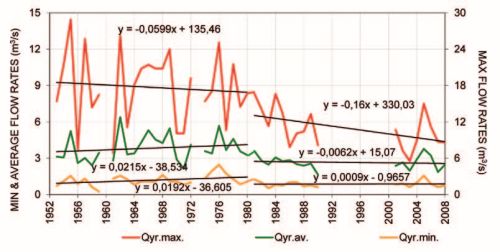Hydrogeology of the sinking zone of the Korana River downstream of the Plitvice Lakes, Croatia
DOI:
https://doi.org/10.3986/ac.v45i1.3057Keywords:
Dinaric karst, Korana River sinking zone, Plitvice Lakes, tracing test, transboundary aquifer, groundwater capturingAbstract
Downstream of the Plitvice Lakes National Park, water that pass through the water system of the lakes begins its flow as the Korana River. A few hundred meters downstream of the source zone, during the summer dry periods, there are losses of water in the riverbed resulting in its total drying. The sinking zone in that area is built of high permeable carbonate rocks and with the appearance of less permeable dolomite rocks, about 17 km downstream, the Korana River becomes a permanent river. This paper focuses on the explanation of hydrogeological relations in the zone where losses of water occur in the riverbed, relationship to the neighbouring Una River catchment, as well as possibilities of relocating the source of water supply from the Kozjak Lake (Plitvice Lakes) to the new site in the sinking zone of the Korana River. For this purpose hydrogeological researches were performed, with drilling of several piezometric boreholes and two tracing tests to determine the direction of groundwater flow during the dry season. The results show that during the dry periods in the sinking zone of the Korana River the groundwater level with active aquifer is about 25 m below the riverbed. This opens up the possibility of additional research to solve the problem of water-supply and relocation of water-supply capture in this area. Two tracing tests showed a connection with the Klokot spring (Bosnia and Herzegovina) in the neighbouring Una River catchment, which points to the transboundary character of this aquifer. At the source of the Klokot minimum discharge is around 3 m3/s and the maximum more than 75 m3/s. The capturing of about 60 l/s for water-supply in the Korana River sinking zone will not have impact on the amount of discharge at the Klokot spring.
Key words: Dinaric karst, Korana River sinking zone, Plitvice Lakes, tracing test, transboundary aquifer, groundwater capturing.
Hidrogeologija ponornega območja reke Korane dolvodno od Plitviških jezer, Hrvaška
Dolvodno od Nacionalnega parka Plitviška jezera vode, ki tečejo skozi sistem jezer, oblikujejo reko Korano. Nekaj sto metrov pod to izvirno cono v času poletnih sušnih obdobij voda v strugi ponika in s časom povsem presahne. Ponorno cono gradijo zelo dobro prepustne karbonatne kamnine in šele po prehodu na manj prepustne dolomite približno 17 km nižje po strugi Korana postane stalna reka. V članku so obravnavane hidrogeološke razmere v coni ponikanja vode v strugi in odnosi s sosednjim porečjem reke Une, pa tudi možnosti prestavitve vira oskrbe s pitno vodo iz jezera Kozjak (Plitviška jezera) na novo lokacijo v ponorni coni reke Korane. V ta namen so bile izvedene hidrogeološke raziskave, izvrtanih je bilo več piezometrskih vrtin in izvedena sta bila dva sledilna poskusa za določitev smeri podzemnega toka v času nizkih vod. Rezultati so pokazali, da je v sušnih obdobjih v ponorni coni reke Korane nivo podzemne vode z aktivnim vodonosnikom približno 25 m pod strugo. To odpira možnost dodatnih raziskav za rešitev problema oskrbe z vodo in prestavitve zajetja vode na tem območju. Oba sledilna poskusa sta dokazala povezavo z izvirom Klokot (Bosna in Hercegovina) v sosednjem porečju reke Une, kar kaže na čezmejni značaj vodonosnika. Minimalni pretok izvira Klokot je približno 3 m3/s, maksimalni pa več kot 75 m3/s. Zajetje za oskrbo z vodo v ponorni coni reke Korane z izdatnostjo približno 60 l/s ne bo imelo vpliva na pretok izvira Klokot.
Ključne besede: Dinarski kras, ponorna cona reke Korane, Plitviška jezera, sledilni poskus, čezmejni vodonosnik, zajetje podzemne vode.
Downloads

Downloads
Published
How to Cite
Issue
Section
License
Authors guarantee that the work is their own original creation and does not infringe any statutory or common-law copyright or any proprietary right of any third party. In case of claims by third parties, authors commit their self to defend the interests of the publisher, and shall cover any potential costs.
More in: Submission chapter




